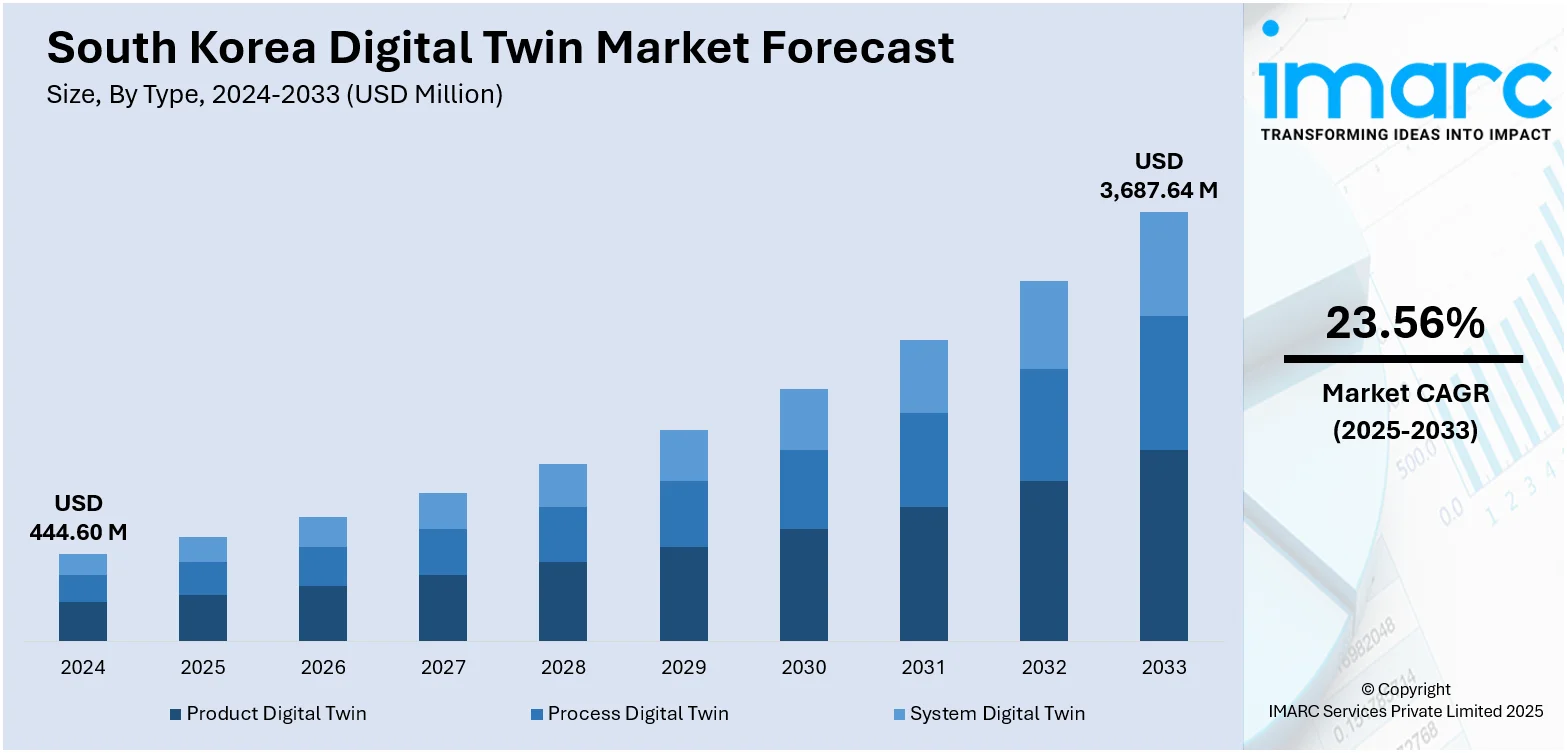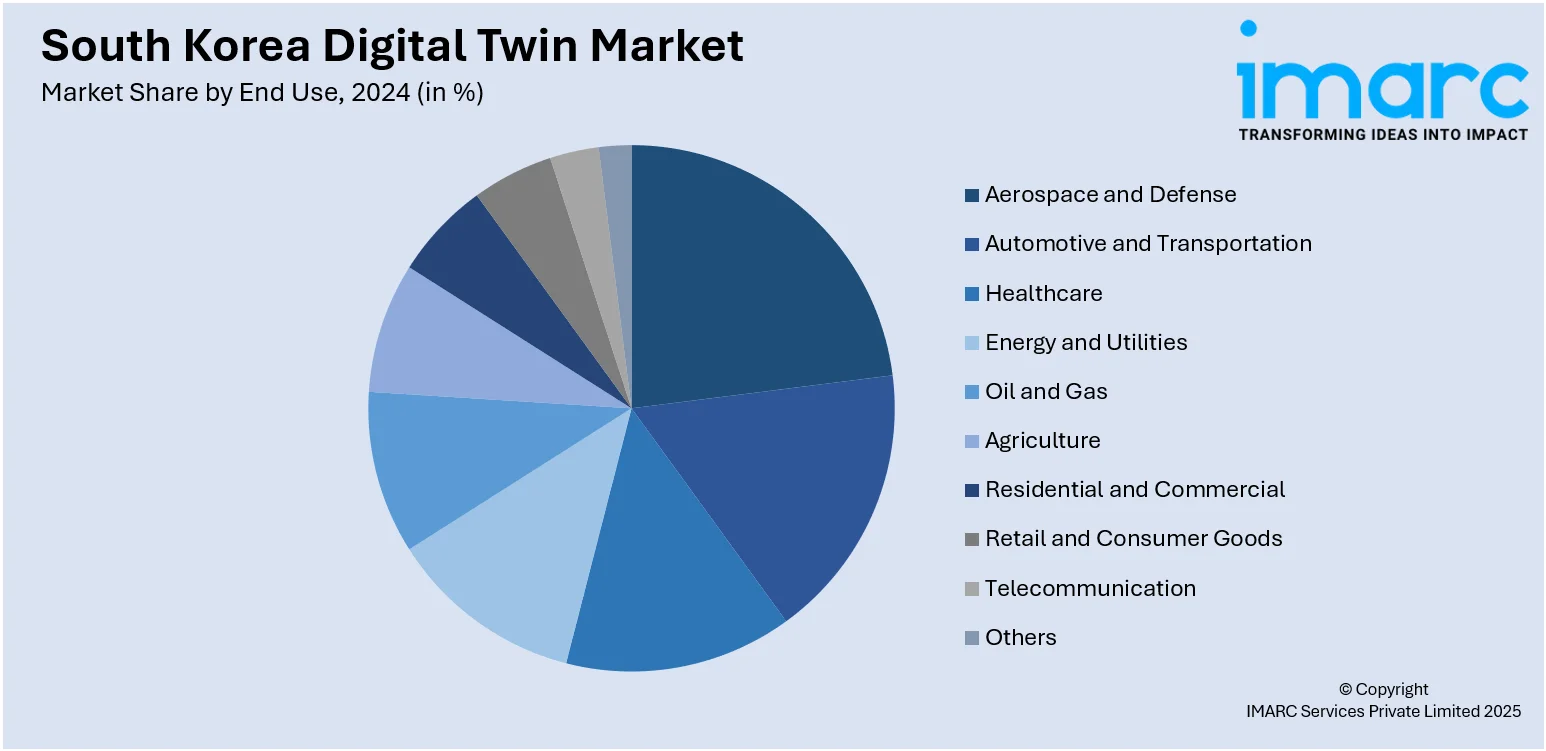
South Korea Digital Twin Market Size, Share, Trends and Forecast by Type, Technology, End Use, and Region, 2025-2033
South Korea Digital Twin Market Overview:
The South Korea digital twin market size reached USD 444.60 Million in 2024. Looking forward, the market is expected to reach USD 3,687.64 Million by 2033, exhibiting a growth rate (CAGR) of 23.56% during 2025-2033. The market is driven by robust Industry 4.0 adoption, widespread IoT and AI integration across sectors, significant public sector backing through smart city and digital government initiatives, and demand for predictive analytics and real-time optimization tools. South Korea digital twin market share is also boosted by early digital transformation and national support.
|
Report Attribute
|
Key Statistics
|
|---|---|
|
Base Year
|
2024
|
|
Forecast Years
|
2025-2033
|
|
Historical Years
|
2019-2024
|
| Market Size in 2024 | USD 444.60 Million |
| Market Forecast in 2033 | USD 3,687.64 Million |
| Market Growth Rate 2025-2033 | 23.56% |
South Korea Digital Twin Market Trends:
Growing Adoption Across Manufacturing and Industrial Sectors
The South Korea digital twin market is witnessing rapid adoption across manufacturing and industrial sectors, driven by the need for greater operational efficiency and cost reductions. Digital twins are being utilized to simulate physical assets and processes in real-time, allowing companies to optimize production, monitor performance, and predict maintenance needs. This technology enhances decision-making by providing accurate insights into machinery health and system behaviors, leading to improved production outcomes. As South Korea's manufacturing sector remains a significant part of its economy, industries such as automotive, electronics, and heavy industries are leading the way in adopting digital twin technology. This trend reflects the increasing demand for smart manufacturing solutions, contributing to the South Korea digital twin market growth. For instance, in October 2024, Korea Hydro & Nuclear Power (KHNP) developed a full digital twin of the APR1400 reactor’s control systems after four years of research. Housed at KHNP’s Innovative MMIS Centre in Daejeon, this virtualized system mirrors actual safety and non-safety controllers, enabling design verification, failure analysis, and real-time simulations. It enhances operational safety, supports exports, and will aid KHNP's role in the Czech nuclear project. South Korea currently operates four APR1400 units, with more under construction and others in commercial use abroad, including the UAE’s Barakah plant.

To get more information on this market, Request Sample
Expansion in Urban Planning and Smart Cities
Digital twin technology is gaining traction in urban planning and smart city initiatives in South Korea. By creating virtual replicas of urban environments, authorities can analyze traffic patterns, energy consumption, and infrastructure health, enabling more efficient urban management. Cities like Seoul are leveraging digital twins to enhance city planning, improve traffic flow, and optimize resource allocation. The growing emphasis on sustainability and intelligent urban infrastructure has accelerated this trend, as digital twins offer a powerful tool for enhancing city operations and mitigating challenges such as pollution and overcrowding. With the South Korean government's support for smart city initiatives, the adoption of digital twins is expected to play a central role in future urban development and public services. For instance, in November 2024, Naver Corporation and Saudi Arabia’s National Housing Company launched a joint venture to develop digital twin platforms for smart city projects. The initiative will enhance urban planning, public services, and disaster prediction using virtual replicas of real environments.
South Korea Digital Twin Market Segmentation:
IMARC Group provides an analysis of the key trends in each segment of the market, along with forecasts at the country and regional levels for 2025-2033. Our report has categorized the market based on type, technology, and end use.
Type Insights:
- Product Digital Twin
- Process Digital Twin
- System Digital Twin
The report has provided a detailed breakup and analysis of the market based on the type. This includes product digital twin, process digital twin, and system digital twin.
Technology Insights:
- IoT and IIoT
- Blockchain
- Artificial Intelligence and Machine Learning
- Augmented Reality, Virtual Reality and Mixed Reality
- Big Data Analytics
- 5G
A detailed breakup and analysis of the market based on the technology have also been provided in the report. This includes IoT and IIoT, blockchain, artificial intelligence and machine learning, augmented reality, virtual reality and mixed reality, big data analytics, and 5G.
End Use Insights:

- Aerospace and Defense
- Automotive and Transportation
- Healthcare
- Energy and Utilities
- Oil and Gas
- Agriculture
- Residential and Commercial
- Retail and Consumer Goods
- Telecommunication
- Others
The report has provided a detailed breakup and analysis of the market based on the end use. This includes aerospace and defense, automotive and transportation, healthcare, energy and utilities, oil and gas, agriculture, residential and commercial, retail and consumer goods, telecommunication, and others.
Regional Insights:
- Seoul Capital Area
- Yeongnam (Southeastern Region)
- Honam (Southwestern Region)
- Hoseo (Central Region)
- Others
The report has also provided a comprehensive analysis of all the major regional markets, which include Seoul Capital Area, Yeongnam (Southeastern Region), Honam (Southwestern Region), Hoseo (Central Region), and others.
Competitive Landscape:
The market research report has also provided a comprehensive analysis of the competitive landscape. Competitive analysis such as market structure, key player positioning, top winning strategies, competitive dashboard, and company evaluation quadrant has been covered in the report. Also, detailed profiles of all major companies have been provided.
South Korea Digital Twin Market News:
- In December 2024, GDIN (Global Digital Innovation Network) supported the global expansion of 10 South Korean digital twin companies, leading to 18 agreements and up to USD 17.2 Million in potential export deals. Through exhibitions like GITEX and ISO standard compliance support, GDIN helped firms like VEStellaLab, Tilda, and RECON Labs connect internationally. The initiative included consulting, certification help, and promotional backing.
- In June 2024, Seoul signed a deal with Techtree Innovation to build a 4㎢ hyper-realistic digital twin of Yeouido. Using advanced 3D scanning and game engine tech, the project will simulate disaster response, traffic, and urban safety scenarios. This initiative aims to support better policy decisions and expand to other areas.
South Korea Digital Twin Market Report Coverage:
| Report Features | Details |
|---|---|
| Base Year of the Analysis | 2024 |
| Historical Period | 2019-2024 |
| Forecast Period | 2025-2033 |
| Units | Million USD |
| Scope of the Report |
Exploration of Historical Trends and Market Outlook, Industry Catalysts and Challenges, Segment-Wise Historical and Future Market Assessment:
|
| Types Covered | Product Digital Twin, Process Digital Twin, System Digital Twin |
| Technologies Covered | IoT and IIoT, Blockchain, Artificial Intelligence and Machine Learning, Augmented Reality, Virtual Reality and Mixed Reality, Big Data Analytics, 5G |
| End Uses Covered | Aerospace and Defense, Automotive and Transportation, Healthcare, Energy and Utilities, Oil and Gas, Agriculture, Residential and Commercial, Retail and Consumer Goods, Telecommunication, Others |
| Regions Covered | Seoul Capital Area, Yeongnam (Southeastern Region), Honam (Southwestern Region), Hoseo (Central Region), Others |
| Customization Scope | 10% Free Customization |
| Post-Sale Analyst Support | 10-12 Weeks |
| Delivery Format | PDF and Excel through Email (We can also provide the editable version of the report in PPT/Word format on special request) |
Key Questions Answered in This Report:
- How has the South Korea digital twin market performed so far and how will it perform in the coming years?
- What is the breakup of the South Korea digital twin market on the basis of type?
- What is the breakup of the South Korea digital twin market on the basis of technology?
- What is the breakup of the South Korea digital twin market on the basis of end use?
- What is the breakup of the South Korea digital twin market on the basis of region?
- What are the various stages in the value chain of the South Korea digital twin market?
- What are the key driving factors and challenges in the South Korea digital twin market?
- What is the structure of the South Korea digital twin market and who are the key players?
- What is the degree of competition in the South Korea digital twin market?
Key Benefits for Stakeholders:
- IMARC’s industry report offers a comprehensive quantitative analysis of various market segments, historical and current market trends, market forecasts, and dynamics of the South Korea digital twin market from 2019-2033.
- The research report provides the latest information on the market drivers, challenges, and opportunities in the South Korea digital twin market.
- Porter's five forces analysis assist stakeholders in assessing the impact of new entrants, competitive rivalry, supplier power, buyer power, and the threat of substitution. It helps stakeholders to analyze the level of competition within the South Korea digital twin industry and its attractiveness.
- Competitive landscape allows stakeholders to understand their competitive environment and provides an insight into the current positions of key players in the market.
Need more help?
- Speak to our experienced analysts for insights on the current market scenarios.
- Include additional segments and countries to customize the report as per your requirement.
- Gain an unparalleled competitive advantage in your domain by understanding how to utilize the report and positively impacting your operations and revenue.
- For further assistance, please connect with our analysts.
 Request Customization
Request Customization
 Speak to an Analyst
Speak to an Analyst
 Request Brochure
Request Brochure
 Inquire Before Buying
Inquire Before Buying




.webp)




.webp)












